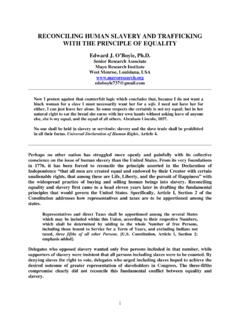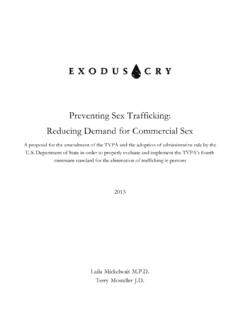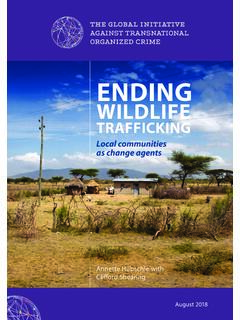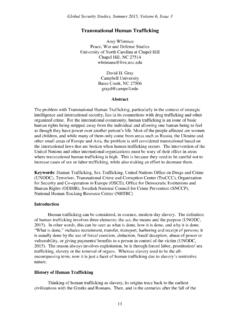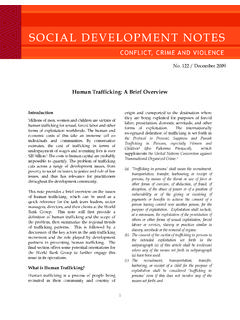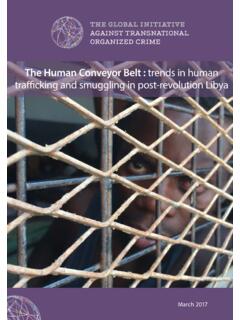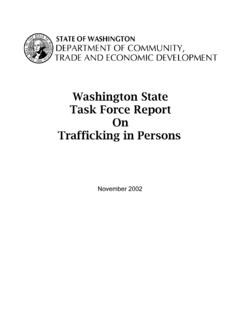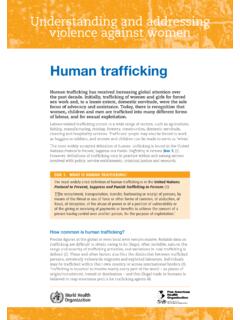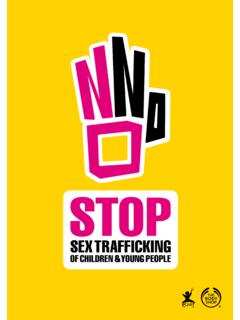Transcription of CNS Global Incidents and - nti.org
1 - 1 - Global Incidents and trafficking DatabaseJuly 2018 CNS Global Incidents and trafficking DatabaseTracking publicly reported Incidents involvingnuclear and other radioactive materials2017 Annual ReportProduced Independently for the Nuclear Threat Initiative by the James Martin Center for Nonproliferation Studies - 2 - Global Incidents and trafficking DatabaseContents Executive SummaryI. Introduction .. 7II. Materials and Data Overview.
2 9 III. Key Findings and Policy Implications ..131. Variable reporting transparency yields variable, low transparency, results ..132. Transportation creates greatest vulnerabilities ..163. Human failure is a security risk ..204. Material replacement ..22IV. Conclusion ..25V. Methodology ..25 JULY 2018 CNS Global Incidents AND trafficking DATABASEA cknowledgmentsThe 2017 report was authored by Shea Cotton, Sam Meyer and Anne Pellegrino with research assistance from John Ryan Bolt. The authors thank Jessica Varnum and George Moore for their peer review comments on an earlier draft of this report , as well as Ferenc Dalnoki-Veress, Francisco Parada, and Nickolas Roth for their suggestions and insights.
3 - 3 - Global Incidents and trafficking DatabaseExecutive SummarySince the fourth and final Nuclear Security Summit (NSS) in April 2016, the issue of nuclear and other radioactive materials security has faded in prominence within the international community. The conclusion of the summit series removed an important Global spotlight on the issue, as well as a high-profile forum for action and accountability. In some cases, reductions in funding and focus are the natural result of programs that have successfully completed their mandates, but research for this report suggests such cases are in the minority.
4 In the United States, funding devoted to nuclear and radioactive materials security has fallen to its lowest level in ten years, even as nuclear weapons programs are receiving significant International tensions have brought joint nuclear security efforts to a near-standstill, and the United Kingdom s withdrawal from the European Union and the European Atomic Energy Community (EURATOM) will necessitate new security ,3 The set of rules and regulations ensuring security of nuclear materials mostly comprises voluntary measures, vulnerable to official neglect or , as illustrated by several 2017 Incidents , the threat of nuclear or other radioactive materials falling into the wrong hands remains significant.
5 For example, in the United States, the FBI discovered a neo-Nazi cell in possession of radioactive americium and thorium, as well as homemade While it is unclear whether the cell wanted to attempt an act of radiological terrorism, and the materials it possessed were likely unsuitable in quantity and isotopic composition, the fact that malicious actors can and do acquire controlled radioactive materials is troubling. In 2017, the James Martin Center for Nonproliferation Studies (CNS) review of open source reports found a total of 171 Incidents of nuclear or other radioactive materials outside of regulatory control, which occurred in 14 countries.
6 Since CNS began comprehensive tracking in 2013, researchers have identified a total of 870 Incidents occurring in 51 countries. Incidents involving nuclear materials (uranium, plutonium, and thorium) are of special concern, because of their potential nuclear weapons applications. In 2017, nine Incidents involved nuclear materials. Of these, two were particularly serious: one incident involved the loss of grams of highly enriched uranium (HEU), while the other involved the attempted illicit sale of plutonium-239 and plutonium-241 taken from a stolen static-electricity control device. In addition to the dangers of nuclear materials out of control, other radioactive materials also carry significant safety and security risks, as discussed in greater detail throughout this report .
7 The IAEA uses a five-level categorization system for radioactive materials and sources, where Category 1 poses the greatest danger to human health and Category 5 poses the least risk. The IAEA s categorization system is based on the type and amount of activity of radioactive material involved, and the relative danger posed by exposure to that material. Incidents involving the most dangerous (Category 1 and 2 materials) are relatively rare. In 2017, zero Category 1 Incidents were reported and only eight Category 2 Incidents were reported. This is consistent with the lack of reports of Category 1 and 2 sources in prior years.
8 In total, from 2013 to 2017, four cases involved a Category 1 source, and 32 involved a Category 2 source. Although these numbers are low, it is impossible to know whether the relative scarcity of Category 1 and 2 cases is artificially low because of Incidents going 3-5 materials are classified as presenting a lower risk than Categories 1 and 2. However, in sufficiently large quantities these materials can still pose significant safety and security risks. The majority of 2017 Incidents involved Categories 3-5 materials, accounting for approximately 68 percent of total reported Incidents . In 27 percent of cases, there was insufficient publicly reported information for CNS researchers to categorize the material 2017 data reinforces the trends and key findings identified in previous editions of this annual reportThe consistency of the data trends over five years lends additional weight to the key findings and related policy recommendations outlined below.
9 - 4 - Global Incidents and trafficking Database The total incident count varies widely by country. In some cases, the variance is logically consistent with the state s overall material holdings. States that do not possess large quantities of nuclear and other radioactive materials would be expected to have fewer Incidents than those with much larger holdings. However, disparities in holdings are only one small part of the Global variance in incident numbers. The transparency, completeness and correctness of states reporting are also important factors.
10 Very few countries systematically report to the public all Incidents involving the loss of radioactive material. The few countries that do routinely publicize Incidents therefore constitute the bulk of entries in this database. Approximately 79 percent of 2017 cases occurred in the six countries that routinely publish Incidents online: the United States, Canada, France, South Korea, Belgium, and Japan. The other 21 percent of 2017 Incidents were located by CNS researchers through exhaustive multi-language searches of media and government sources. The IAEA maintains a confidential Incident and trafficking Database (ITDB), which is generated from voluntary reporting by countries.

